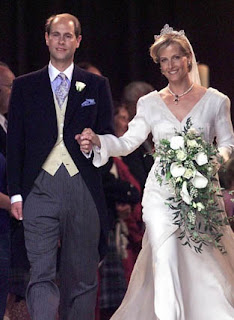Wednesday, June 19, 2013
Happy Annaversary to Their Royal Highnesses The Earl and Countess of Wessex (They have been married 14 years today.)
The wedding of Prince Edward, Earl of Wessex and Sophie Rhys-Jones took place on 19 June 1999 in St George's Chapel at Windsor Castle. The Queen's youngest child, The Prince Edward, was created Earl of Wessex hours before the ceremony. The Prince Edward, youngest child of Elizabeth II, met Sophie Rhys-Jones at a tennis event in 1993. Prince Edward announced his engagement to Sophie on 6 January 1999. Edward proposed to Sophie with a delicate engagement ring featuring a two-carat oval diamond flanked by two heart-shaped gemstones set in 18-karat white gold. This engagement ring was made by Asprey and Garrard (now Garrard & Co) and it is worth an estimated £105,000. The wedding took place at St George's Chapel, Windsor Castle.[4] At the time of their engagement, Edward and Sophie made it known their wish that the wedding not be turned into a state occasion, causing there to be no ceremonial state or military involvement. Prime Minister Tony Blair and other politicians were not invited. Rather than court dress, the couple requested that guests attend wearing formal evening gowns, and not to wear hats to reflect its wish for a more informal royal wedding. Queen Elizabeth The Queen Mother wore a hat regardless, as she was rarely seen in public without one. It was Windsor's largest occasion since the 1952 funeral of King George VI. Edward's two brothers, The Prince of Wales and The Duke of York, both served as his supporters (the royal equivalent of the "best man"). Children of the couple's friends served as Sophie's attendants: Camilla Hadden, Olivia Taylor, Felix Sowerbutts, and Harry Warburton. The three royal brothers chose to leave their limousines behind and walk past the onlookers into the church, twenty minutes before the start of the ceremony. Sophie arrived with her father Christopher Rhys-Jones in a Rolls Royce owned by the Queen, and he walked her down the aisle. Peter Nott, the Bishop of Norwich, performed the ceremony. Unlike previous royal weddings, like that of Prince Charles and Lady Diana, Sophie chose to say the word "obey" in her vow "to love, honour and obey". The couple said their respective vows properly, though some onlookers noted Edward had a little difficulty placing the wedding ring on Sophie's finger. Sophie wore a wedding dress designed by Samantha Shaw. It had a long, fitted coat with long sleeves, along with an ivory train that according to one source was "made from hand-dyed silk organza and hand-dyed silk crepe, with rows of pearls and crystal beading". Notably, the four girls and boys who carried her train were all commoners, the first time this has occurred in a royal wedding. Sophie wore a diamond tiara from the Queen's private collection, as well as a pearl necklace that was given to her by Edward for the wedding; Sophie in turn gave him an 18-carat gold pocket watch. Prince Edward's waistcoat was designed by John Kent. After the ceremony, Edward and Sophie rode in an open, horse-drawn carriage to the reception in St George's Hall at Windsor Castle, passing thousands of people en route. Their wedding cake was adorned with tennis rackets since both of them met each other during a tennis event and like the game of tennis. Hours before the ceremony, The Prince Edward was created Earl of Wessex and Viscount Severn in anticipation of his marriage to public relations manager Sophie Rhys-Jones. Upon their marriage, the couple became known as Their Royal Highnesses The Earl and Countess of Wessex. Some constitutional scholars questioned why Edward had not been created a duke, as his brothers had before their weddings; it was made known at that time that Edward would be created Duke of Edinburgh after the deaths of both his parents. The publishing director of Burke's Peerage, Harold Brooks-Baker, noted that Edward was the first son of a monarch since George I to not be made a duke. Historian David Starkey criticised the choice of title Earl of Wessex, remarking "The title itself is a total fiction. There is nowhere called Wessex...the title has not been used for a thousand years - is it the right way to celebrate the third millennium by going back to the first?"
Subscribe to:
Post Comments (Atom)







No comments:
Post a Comment